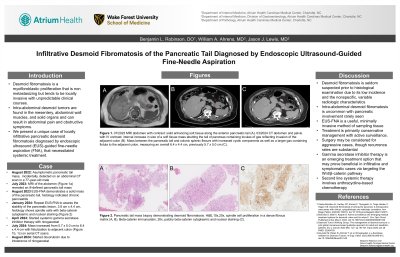Monday Poster Session
Category: Biliary/Pancreas
P1808 - Infiltrative Desmoid Fibromatosis of the Pancreatic Tail Diagnosed by Endoscopic Ultrasound-Guided Fine-Needle Aspiration
Monday, October 28, 2024
10:30 AM - 4:00 PM ET
Location: Exhibit Hall E

Has Audio

Benjamin L. Robinson, DO
Atrium Health
Charlotte, NC
Presenting Author(s)
Benjamin L. Robinson, DO, Jason J. Lewis, MD
Atrium Health, Charlotte, NC
Introduction: Intra-abdominal desmoid fibromatosis is an uncommon, benign clonal myofibroblastic proliferation that tends to be locally invasive with unpredictable clinical courses. Desmoid fibromatosis of the pancreas is even rarer, with fewer than 50 cases previously reported in literature. We present a case of locally infiltrative pancreatic desmoid fibromatosis diagnosed by endoscopic ultrasound (EUS)-guided fine-needle aspiration (FNA), which was ultimately treated with a gamma-secretase inhibitor (GSI).
Case Description/Methods: A 77-year-old male was evaluated for an asymptomatic pancreatic tail mass, first incidentally detected on an abdominal CT scan in August 2022. A contrast-enhanced MRI of the abdomen (Figure 1a) in July 2023 revealed an ill-defined pancreatic tail mass measuring 3.9 x 3.4 x 5.1 cm. In August 2023, he underwent EUS-FNA, which indicated chronic pancreatitis without dysplasia or malignancy. A repeat EUS-FNA (Figure 1c) was performed in January 2024 to assess the stability of the pancreatic lesion. Pathological analysis showed spindle cell proliferation with beta-catenin cytoplasmic and nuclear staining, consistent with pancreatic desmoid fibromatosis. Subsequent CT imaging (Figure 1b) showed an increase in size of the pancreatic mass, which had infiltrated into the adjacent colon. The patient was referred to oncology initiated systemic therapy with the gamma-secretase inhibitor nirogacestat.
Discussion: Pancreatic desmoid fibromatosis is seldom suspected prior to histological examination due to its rare incidence and the nonspecific, variable radiologic characteristics it presents. The differential diagnosis for this condition includes both neoplastic and non-neoplastic lesions, with surgical resection commonly employed to obtain tissue samples. Although EUS-FNA is infrequently utilized for diagnosing pancreatic desmoid, our case demonstrates its effectiveness as a minimally invasive diagnostic modality. Treatment predominantly involves conservative management with active surveillance, reflecting the substantial recurrence rates associated with surgical resection. Surgery may be considered for symptomatic patients if wide surgical margins are achievable. Systemic therapy, particularly with the recent approval of gamma-secretase inhibitors as novel targeted therapy for desmoid tumors, is an emerging area of interest. Our case contributes to the limited literature on the use of gamma-secretase inhibitors in treating pancreatic desmoid fibromatosis.

Disclosures:
Benjamin L. Robinson, DO, Jason J. Lewis, MD. P1808 - Infiltrative Desmoid Fibromatosis of the Pancreatic Tail Diagnosed by Endoscopic Ultrasound-Guided Fine-Needle Aspiration, ACG 2024 Annual Scientific Meeting Abstracts. Philadelphia, PA: American College of Gastroenterology.
Atrium Health, Charlotte, NC
Introduction: Intra-abdominal desmoid fibromatosis is an uncommon, benign clonal myofibroblastic proliferation that tends to be locally invasive with unpredictable clinical courses. Desmoid fibromatosis of the pancreas is even rarer, with fewer than 50 cases previously reported in literature. We present a case of locally infiltrative pancreatic desmoid fibromatosis diagnosed by endoscopic ultrasound (EUS)-guided fine-needle aspiration (FNA), which was ultimately treated with a gamma-secretase inhibitor (GSI).
Case Description/Methods: A 77-year-old male was evaluated for an asymptomatic pancreatic tail mass, first incidentally detected on an abdominal CT scan in August 2022. A contrast-enhanced MRI of the abdomen (Figure 1a) in July 2023 revealed an ill-defined pancreatic tail mass measuring 3.9 x 3.4 x 5.1 cm. In August 2023, he underwent EUS-FNA, which indicated chronic pancreatitis without dysplasia or malignancy. A repeat EUS-FNA (Figure 1c) was performed in January 2024 to assess the stability of the pancreatic lesion. Pathological analysis showed spindle cell proliferation with beta-catenin cytoplasmic and nuclear staining, consistent with pancreatic desmoid fibromatosis. Subsequent CT imaging (Figure 1b) showed an increase in size of the pancreatic mass, which had infiltrated into the adjacent colon. The patient was referred to oncology initiated systemic therapy with the gamma-secretase inhibitor nirogacestat.
Discussion: Pancreatic desmoid fibromatosis is seldom suspected prior to histological examination due to its rare incidence and the nonspecific, variable radiologic characteristics it presents. The differential diagnosis for this condition includes both neoplastic and non-neoplastic lesions, with surgical resection commonly employed to obtain tissue samples. Although EUS-FNA is infrequently utilized for diagnosing pancreatic desmoid, our case demonstrates its effectiveness as a minimally invasive diagnostic modality. Treatment predominantly involves conservative management with active surveillance, reflecting the substantial recurrence rates associated with surgical resection. Surgery may be considered for symptomatic patients if wide surgical margins are achievable. Systemic therapy, particularly with the recent approval of gamma-secretase inhibitors as novel targeted therapy for desmoid tumors, is an emerging area of interest. Our case contributes to the limited literature on the use of gamma-secretase inhibitors in treating pancreatic desmoid fibromatosis.

Figure: Figure 1. 07/2023 MRI abdomen with contrast: solid enhancing soft tissue along the anterior pancreatic tail (A). 03/2024 CT abdomen and pelvis with IV contrast: interval increase in size of a soft tissue mass abutting the tail of pancreas containing locules of gas reflecting invasion of the adjacent colon (B). 01/2024 EUS: heterogeneous and hypoechoic mass with poorly defined and irregular margins (C).
Disclosures:
Benjamin Robinson indicated no relevant financial relationships.
Jason Lewis indicated no relevant financial relationships.
Benjamin L. Robinson, DO, Jason J. Lewis, MD. P1808 - Infiltrative Desmoid Fibromatosis of the Pancreatic Tail Diagnosed by Endoscopic Ultrasound-Guided Fine-Needle Aspiration, ACG 2024 Annual Scientific Meeting Abstracts. Philadelphia, PA: American College of Gastroenterology.

